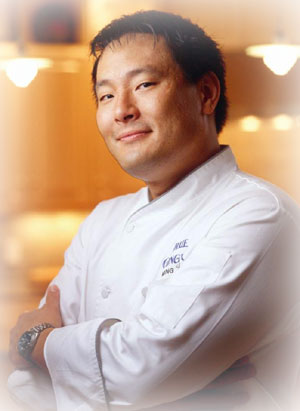Chef Ming Tsai:
Voice of Fusion
Ming Tsai discusses the private struggles behind the empire built on his ability to lay down all-American patter to garnish his East/West platters.
PAGE 1 OF 4
|
GOLDSEA | ASIAMS.NET | ASIAN AMERICAN PERSONALITIES
THE 130 MOST INSPIRING ASIAN AMERICANS Chef Ming Tsai: |
My schtick is that I learned first traditionally how to use those ingredients and techniques. I specifically went to Japan with one mission -- how to make sushi rice. So I traditionally learned how to make those things first. I know I've been blessed and I've had opportuities to live and work in France, live and work in Japan. That shouldn't discourage people. You can just go to the best Japanese restaurant in town and still learn from a Japanese chef. You don't have to literally go to that country. It's better to be immersed, but in either case, learn first how that culture uses the traditional ingredient or technique, and then you've earned the right to start blending it into your own style of food. If you learn from Chinese or Coreans who use a lot of ginger how you store it, buy it, chop it up, you would never throw it into a food processor or a blender because all you end up with is a lot of strings. That's a typical mistake. People would think, "I have a food processor, I can throw it in there." That works for onions,. It doesn't work for ginger. I've seen some great tuna carpaccio dishes that even some chefs dribble sesame oil on the plate which is what you do with extra virgin olive oil. But sesame oil is such a strong oil, so flavored, so deep in its flavor that, one, you don't even taste the tuna, and two, you taste sesame oil for the next three courses. You're doing a disservice by usiing sesame oil. If you learn traditionally how the Chinese use sesame oil, we would use a tablespoon in four quarts of chicken stock because it's so strong flavored.
GS: How about for the casual weekend chefs? What do you see as their big misconception?
MT: I don't know there are misconceptions. They're just trying to have fun and put food on the table. I think a common misake is that people follow the recipe to the T and don't use common sense and taste as they go. I tell all my cooks here, I tell everyone I ever train, you have to taste as you go because things are diferent. Water is different from town to town. Flour, rice, temperature -- all these things can affect how things taste. A carrot does not taste like a carrot like a carrot like a carrot. If you get a carrot just harvested, you don't have to put anything on it because it's so bloody sweet, but you get a carrot that's a couple of days old, you're going to have to season it more or cook it more. A recipe -- like my two books [Blue Ginger and Simply Ming] -- they're not gospel, they're a foundation. They're my idea of how you should treat these food products, and if you want to put an Asian flair to it, this is what you should do. But that should be a foundation for inspiration. I've always said that a succedssful cook is not someone who makes my dish and it comes out great. That's good because you spent $32.50, but a successful cook is someone that takes my recipe and adds their own culture to it, either adds chili if they're from Mexico or eggplant if they're an eggplant freak or they take out something but they make the recipe their own. If someone can be inspird by a book, take a base recipe, change it so it really meets what they like to eat, and it turns out to be a great dish, that's a successful cookbook.PAGE 2
 |
“But sesame oil is such a strong oil, so flavored, so deep in its flavor that, one, you don't even taste the tuna.” |
CONTACT US
|
ADVERTISING INFO
© 1996-2013 Asian Media Group Inc
No part of the contents of this site may be reproduced without prior written permission.

 ome people are verbal sprinters. They dash off a sentence or two in bursts, then stop for air and appreciation. Ming Tsai is a miler. He redlines the ear's processing capacity for a minute or three without pause or prompting, as though to finish before something burns. It's a striking reminder that Tsai's kitchen god status was built on his ability to fluidly deconstruct fusion techniques between bastings, wok tosses and commercial breaks. It doesn't hurt that, at newly 40, he retains the cherub-cheeked good looks and boyish breathlessness that first set female hearts mincing and reassured male gourmands that you don't need a goofy accent to get exotic.
ome people are verbal sprinters. They dash off a sentence or two in bursts, then stop for air and appreciation. Ming Tsai is a miler. He redlines the ear's processing capacity for a minute or three without pause or prompting, as though to finish before something burns. It's a striking reminder that Tsai's kitchen god status was built on his ability to fluidly deconstruct fusion techniques between bastings, wok tosses and commercial breaks. It doesn't hurt that, at newly 40, he retains the cherub-cheeked good looks and boyish breathlessness that first set female hearts mincing and reassured male gourmands that you don't need a goofy accent to get exotic.